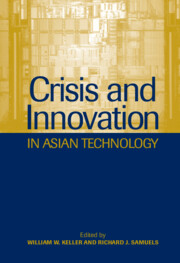Book contents
- Frontmatter
- Contents
- Figures and Tables
- Contributors
- Acknowledgments
- 1 Innovation and the Asian Economies
- 2 Japanese Production Networks in Asia: Extending the Status Quo
- 3 Crisis and Innovation in Japan: A New Future through Technoentrepreneurship?
- 4 Crisis, Reform, and National Innovation in South Korea
- 5 From National Champions to Global Partners: Crisis, Globalization, and the Korean Auto Industry
- 6 Crisis and Adaptation in Taiwan and South Korea: The Political Economy of Semiconductors
- 7 China in Search of a Workable Model: Technology Development in the New Millennium
- 8 Economic Crisis and Technological Trajectories: Hard Disk Drive Production in Southeast Asia
- 9 Continuity and Change in Asian Innovation
- Index
6 - Crisis and Adaptation in Taiwan and South Korea: The Political Economy of Semiconductors
Published online by Cambridge University Press: 15 December 2009
- Frontmatter
- Contents
- Figures and Tables
- Contributors
- Acknowledgments
- 1 Innovation and the Asian Economies
- 2 Japanese Production Networks in Asia: Extending the Status Quo
- 3 Crisis and Innovation in Japan: A New Future through Technoentrepreneurship?
- 4 Crisis, Reform, and National Innovation in South Korea
- 5 From National Champions to Global Partners: Crisis, Globalization, and the Korean Auto Industry
- 6 Crisis and Adaptation in Taiwan and South Korea: The Political Economy of Semiconductors
- 7 China in Search of a Workable Model: Technology Development in the New Millennium
- 8 Economic Crisis and Technological Trajectories: Hard Disk Drive Production in Southeast Asia
- 9 Continuity and Change in Asian Innovation
- Index
Summary
Widely cited by comparative political economists as paradigmatic cases of the developmental state, South Korea and Taiwan constructed vibrant but vulnerable national economies during the latter decades of the twentieth century. Seeking to enter the leading ranks in the world economy, both were committed to moving indigenous industries rapidly up the technological value chain. In the contemporary period, no industry better exemplifies this effort than the one that develops and produces semiconductors — core elements in burgeoning global telecommunications, computer, and computer equipment industries. Notoriously cyclical, the industry poses complex challenges for business and government.
Two Approaches to Innovation in the Semiconductor Industry
This chapter examines the question of whether continuity or change is more characteristic of the semiconductor industries of South Korea and Taiwan. Each developed a distinctive strategic approach to achieving its national aspirations in this critical industry. The regional financial shock of 1997–98 brought these differences more fully into view, as did the global downturn in the information technology industries in 2001–2. Taiwan and Korea have long pursued industrial policies structured to advance national strategies in this sector. We argue, however, that Taiwan's more flexible and pragmatic approach, the core of its “foundry” model of chip production, enabled it to weather the financial crisis of the late 1990s, and even to find new opportunities.
- Type
- Chapter
- Information
- Crisis and Innovation in Asian Technology , pp. 137 - 159Publisher: Cambridge University PressPrint publication year: 2003
- 4
- Cited by



